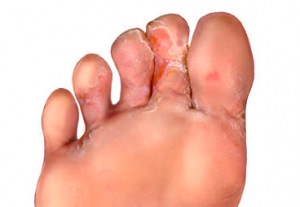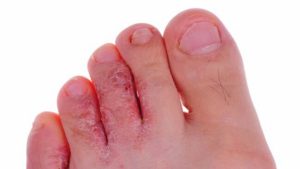 Athlete’s Foot describes a fungal skin infection that develops on the bottom of the feet and between the toes. It affects the outer layer of the foot and can get very itchy and frustrating. Many people will experience Athlete’s Foot at some point in their lives, or even many times, because it is easily spread through sharing surfaces with those affected. It is medically referred to as tinea pedis which literally translates to ‘ringworm of the foot’ and gets the name ‘Athlete’s Foot’ because of its high prevalence among athletes.
Athlete’s Foot describes a fungal skin infection that develops on the bottom of the feet and between the toes. It affects the outer layer of the foot and can get very itchy and frustrating. Many people will experience Athlete’s Foot at some point in their lives, or even many times, because it is easily spread through sharing surfaces with those affected. It is medically referred to as tinea pedis which literally translates to ‘ringworm of the foot’ and gets the name ‘Athlete’s Foot’ because of its high prevalence among athletes.
What causes Athlete’s Foot?
A fungus (called Trichophyton) is the cause of Athlete’s Foot and is contracted through direct contact with the fungus. When the fungus is paired with warm and damp conditions, it can quickly grow and spread over the bottom of the foot. This is why the athlete’s foot is often contracted from and thrives in showers, changing rooms and closed-in shoes.Be careful, your toenails are also vulnerable to fungal nail infections. These are often difficult to treat, even in drier and cooler conditions.
What are the symptoms?
If you have contracted Athlete’s Foot, you might experience: Itching
Itching- Red, scaly patches on the skin
- Dry appearance
- Stinging or burning
- Breakdown of the skin between the toes that may cause cracks or fissures
Treatment
Before any treatment can be started, we must confirm the presence of a fungal. Your podiatrist is expertly trained to know the signs and symptoms, and can differentiate athlete’s foot from other skin conditions that may have a similar presentation. If you have the aforementioned symptoms and your feet are also particularly odorous, you may have both a fungal and bacterial infection simultaneously. If so, your required treatment will differ from a fungal infection alone. Once the athlete’s foot is confirmed, you can start by doing as much as you can at home to keep the feet dry, clean, and away from sources of infection. These typically include:- Thoroughly drying your feet with a towel after showering or getting wet
- Using absorbent powders if your feet sweat excessively
- Disinfecting infected shoes and socks to demote reinfection
- Wearing socks that will promote a dry environment
- Wearing open shoes where possible to let the feet air and dry








